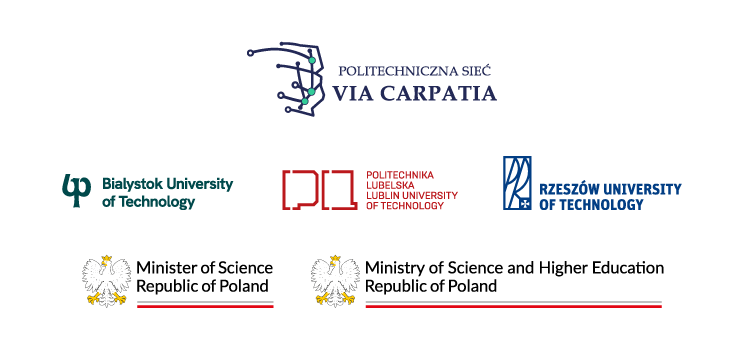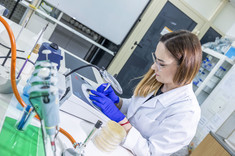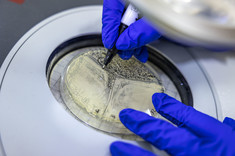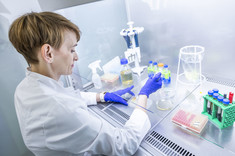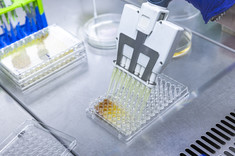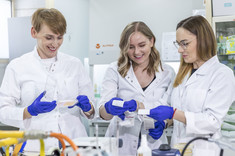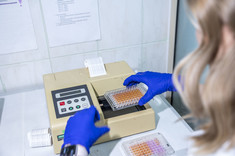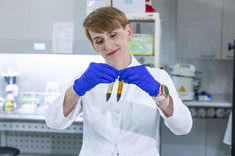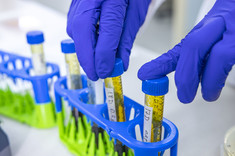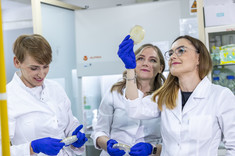Evaluation of the antimicrobial activity of selected European fungal species of the genus Phellinus s.l....
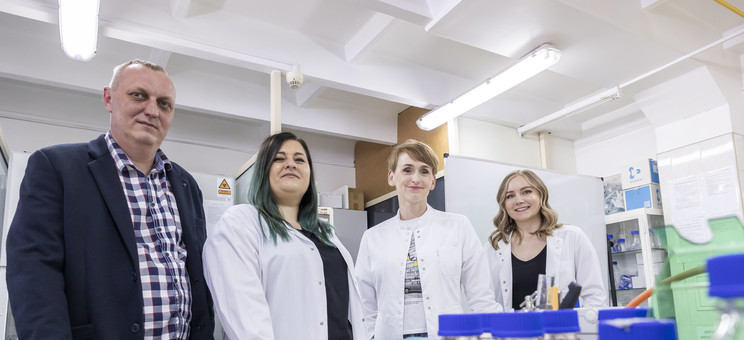
Project is performed within the VIA CARPATIA Polytechnic Network ointhe name of the President of the Republic of Poland Lech Kaczyński. The project manager is Ewa Ciszkowicz, PhD from the Department of Biotechnology and Bioinformatics at the Faculty of Chemistry of the Rzeszów University of Technology. The research project is carried out by a cooperation of three research groups: research team from the Białystok University of Technology, the Lublin University of Technology and the Rzeszów University of Technology. The project leader is the Rzeszów University of Technology.
Research team
Bialystok Technical University: Principal Investigator: Ewa Zapora, PhD,, Research team members: Monika Kalinowska BEng, PhD, DSc, Assoc. Prof., Włodzimierz Lewandowski, PhD, DSc, ProfTit., Renata Świsłocka, PhD, DSc, Assoc. Prof., Elżbieta Wołejko, PhD, DSc, Assoc. Prof., Agata Jabłońska-Trypuć, PhD, DSc, Assoc. Prof., Urszula Wydro, BEng, PhD, Marcin Stocki, PhD, Ewelina Gołębiewska, BEng, MSc, Marek Wołkowycki
Lublin University of Technology: Principal Investigator: Małgorzata Pawłowska, PhD, DSc, ProfTit., Research team members: Grzegorz Łagód, BEng, PhD, DSc, Assoc. Prof., Jacek Czerwiński, BEng, PhD, DSc, Assoc. Prof., Magdalena Zdeb, BEng, PhD, Marta Bis, BEng, PhD, Justyna Kujawska, PhD
Rzeszow University of Technology: Principal Investigator: Ewa Ciszkowicz, PhD, Research team members: Aleksandra Bocian, BEng, PhD, DSc, Assoc. Prof., Marcin Jaromin BEng, MSc
Project description
Antibiotic resistance is an increasingly frequent and significant threat to humans, and the dimension of this phenomenon has made it one of the key dangers to public health worldwide. When antibiotics were referred to as ‘miracle drugs’ in the 1940s and 1950s, no one imagined that within just one generation bacteria would become resistant to antibiotics and the situation would change dramatically. As a result of antibiotic resistance, around 700,000 people die each year in Europe alone, and forecasts indicate that this number will reach 10 million people a year by 2050. New, effective antibiotics are virtually non-existent, thus increasing the mortality rate from infections caused by resistant bacteria.
The huge increase in interest in fungi as reservoirs of natural active compounds observed in recent years is due to their wide range of biological activities. Mushrooms have not only been recognised as part of the human diet for centuries, but have also been used for about 7,000 years in traditional Chinese medicine. Among the macrofungi, there is, among others, a numerous group with proven, powerful pharmacological properties. These are known as Medicinal Mushrooms. Studies confirm their anticancer, immunomodulatory, anti-inflammatory, antioxidant, antiviral, antibacterial, antifungal, antiparasitic, antihypercholesterolemic, detoxifying, hepatoprotective and antidiabetic effects.
The possibility of using fungi for medicinal preparations is determined by their two important features: the ability to biosynthesise secondary metabolites with potent biological effects and the possession of an extremely elaborate enzymatic apparatus, enabling complex biotransformation reactions. Fungi support the immune system and are also successfully used in the treatment of neurodegenerative or civilisation diseases (Alzheimer’s disease, diabetes). Currently, extracts from fungi or fractions of bioactive compounds isolated from them are used in the production of medicines, dietary supplements, food additives and food for special medical purposes.
Scientific reports confirm the high documented antibacterial activity of medicinal fungi, including Staphylococcus aureus, Streptococcus agalactiae and Escherichia coli. The genus Phellinus s.l. belongs to the family Hymenochaetaceae and includes more than 220 described taxa worldwide, with 35 taxa in Europe. Some species belonging to this genus have been traditionally used in Chinese medicine and have proven health-promoting effects. However, Phellinus s.l. is a taxonomically difficult genus and although it is rich in species only a small proportion of them have been studied. Most of the available activity studies concern only a few species, including Phellinus igniarius, P. linteus, P. gilvus, P. pini or P. hartigii. For the vast majority of European and global taxa, there are no data on their activity in the literature.
In this project, the Bialystok University of Technology will test extracts from selected European fungi of the genus Phellinus s.l., which have not yet been tested for their biological properties, to assess their antimicrobial activity. As part of the project, all Phellinus s.l. extracts produced for the research will be included in the Fungi Extract Bank® (FEB), a collection containing currently more than 250 extracts of arboreal fungi collected at the Institute of Forest Sciences, Bialystok University of Technology, often from unique and rare species.
The subject of the research will be a collection of selected European taxa of fungi of the genus Phellinus s.l. from the area of Poland and North Macedonia (a collection of taxa characteristic of the Mediterranean zone that do not occur in Poland). The innovation of the project is related to the coverage of the majority of European species that have not been studied in this respect so far. The lack of research in this direction is related to the extremely difficult process of taxonomic identification, which few specialist mycologists in the world, including an employee of the Institute of Forest Sciences (Bialystok University of Technology), are able to perform correctly. Extracts will be made from the collected fruiting bodies using the classical solvent extraction method, which will form the basis for antioxidant and antimicrobial studies.
In order to confirm the taxonomic position of the fungal species under study and to obtain comprehensive information on the sequence of genes involved in the production and/or degradation of the target active substances, a comprehensive and comprehensive genetic characterisation will be carried out at the Rzeszów University of Technology using Next Generation Sequencing (NGS) technology. Planned analyses include whole-genome sequencing with 30-50-fold coverage in order to obtain sequences necessary for species identity and to learn about genes important for biodegradation and biosynthesis of biologically active compounds. The results obtained can form the basis for further research towards commercial applications and the planning of biotechnological processes.
Antimicrobial and antioxidant studies of extracts from selected fungal species of the genus Phellinus s.l. will be carried out at the Bialystok University of Technology in order to select fungal species with the highest antimicrobial and antioxidant potential from the genus Phellinus s.l. and to determine by spectroscopic methods the fraction of chemical compounds present in dried fungal fruiting bodies and their extracts. Antimicrobial tests will be performed on selected certified bacterial (Escherichia coli, Klebsiella pneumoniae, Pseudomonas aeruginosa, Staphylococcus aureus, Staphylococcus epidermidis, Kocuria rhizophila and Lactobacillus rhamnosus) and fungal (Candida albicans) strains. The value of the Minimum Inhibitory Concentration (MIC) and the zones of inhibition of microbial growth for selected concentrations of extracts will be determined by using the Kirby-Bauer disc-diffusion method to compare their activity with antibiotics. For the extracts with the highest antimicrobial activity, in vitro cytotoxicity studies are also planned, as well as an evaluation of the antioxidant activity of the extracts, which will identify the Phellinus s.l. species with the highest antiradical potential. To this end, spectrophotometric antioxidant activity tests will be performed, including the DPPH radical test, the ABTS cation radical test and the lipid peroxidation test.
Knowing the chemical composition of the active substances present in extracts is of great importance for assessing the therapeutic effect of potential preparations. It will also make it possible to assess which chemical substances are responsible for the biological activity. Therefore, qualitative and quantitative identification of active substances in selected extracts, determination of macro- and microelements, determination of elemental composition (C, N, H, S) and thermal decomposition studies of extracts will be carried out. The content of active substances in the tested extracts will be determined by gas chromatography-mass spectrometry (GC-MS). Macro- and microelements will be determined by atomic absorption spectroscopy, while elemental content (C, N, H, S) will be determined by elemental analysis. Using thermogravimetric analysis (TG, DTG, DSC), the water content and susceptibility of the samples to decomposition under elevated temperature will be determined.
Despite extensive knowledge of medical fungi, the active substances in their composition and the mechanisms responsible for their antimicrobial effects, especially against pathogenic bacterial strains showing multidrug resistance, are not fully understood. Therefore, Rzeszów University of Technology will evaluate the antibacterial activity of selected extracts against clinical pathogenic bacterial strains with defined drug resistance by determining the MIC and Minimum Bactericidal Concentration (MBC) values. Extracts with the highest antibacterial and antioxidant potential, selected in earlier stages against clinical pathogenic bacterial strains (Escherichia coli, Pseudomonas aeruginosa, Staphylococcus aureus and Staphylococcus epidermidis), will be tested.
At the stage of assessing the possibility of using the selected extracts as a source of substances with antimicrobial activity, it is necessary to exclude their cytotoxicity towards normal human cells in an in vitro system. To this end, viability analyses of human normal fibroblast (BJ, HsSK) and keratinocyte (HaCaT) lines in response to treatment with the selected extracts will be performed. The ability to reduce H2O2-induced oxidative stress in human cells by reducing malondialdehyde (MDA) levels, improving the activity of antioxidant enzymes, i.e. superoxide dismutase, catalase and glutathione peroxidase, will also be investigated.
When considering the possibility of using fungal extracts on an industrial scale, it is also important to consider how the residue from the extraction process is managed. Due to its organic nature, a possible management route is to use it, for example, for biogas production. However, due to the complex chemical composition of the biomass from the extraction of selected fungi species and the presence of residues of different types of extractants in the biomass, there is a risk of fermentation inhibition. The biogas potential of such materials is also unknown. The uncontrolled release of extract residues or bioactive substances contained in the extracts into the environment, where they may affect the biochemical processes that take place there, may also be an environmental problem. The potential use of fungi, e.g. in the production of drugs or enzymatic preparations for biomass pretreatment, involves such risks, in particular their presence in wastewater and methane-fermented biomass. In order to be able to predict the consequences of extracts entering the environment, it is necessary, among other things, to evaluate their biodegradability, both under aerobic and anaerobic conditions, as well as to assess their impact on organisms, including microorganisms inhabiting activated sludge bioreactors and digesters in wastewater treatment plants. This area of research will be carried out at the Lublin University of Technology.
Fungi are unique organisms, not only from the perspective of their importance in the functioning of the forest environment, but also because of their activity, which can be of fundamental importance for human and animal health. They are at the top of the researchers’ interest due to the fact that they are reservoirs of a huge number of natural active compounds with a wide range of activities. Particularly valuable are the so-called medicinal mushrooms, a group with strong pharmacological properties that have also been proven in clinical studies.
The research planned during the project has both a scientific and a practical dimension. Firstly, the planned field mycological surveys are always carried out in such a way that both the target fruiting bodies (in this case, from the genus Phellinus s.l.) and a larger number of fungal taxa are collected. The result of such extensive taxonomic and genetic research may be the discovery of fungal species new to Poland, Europe and even science. In addition, in-depth taxonomic and genetic studies of rare taxa of fungi of the genus Phellinus s.l. will provide new and up-to-date knowledge on the distribution and abundance of these species in the forests of Poland and North Macedonia. Another very important scientific dimension of the project is new knowledge on the biological activity of the collected species, which have not been studied at all so far on a European scale and in the context of their antimicrobial activity. The expected results of the implementation of the research also have a practical and applied dimension. The research undertaken is an example of science for society. It can have a global dimension, and the direct beneficiaries of the effects will be humans and animals (both in the context of treatment and prevention). Scientists, foresters, and employees of nature conservation institutions are, in turn, the beneficiaries of the practical effects of research into the biodiversity of mycobiota of fungi of the genus Phellinus s.l. from Poland and Europe.
